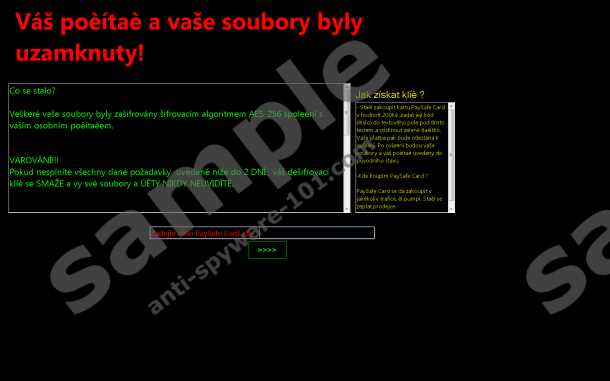What is Czech Ransomware?
Czech Ransomware is a new computer infection developed by cyber criminals to receive money from computer users. As the name of this ransomware suggests, it is targeted at those users who live in the Czech Republic; however, theoretically, it might slither onto your computer wherever you live. Do not worry; it will become immediately clear for you that a ransomware infection has sneaked onto the computer because a black screen with the text will cover your Desktop, meaning that you will no longer be able to access your Desktop. We understand how it is important for you to reach your programs and files, so we suggest getting rid of Czech Ransomware as soon as possible. It will not be very easy to eliminate it because this screen-locking window cannot be removed, and you will have to enter the Safe Mode (or Safe Mode with Networking). Let us help you do that – read this article attentively from beginning to end and then use our manual removal guide.
What does Czech Ransomware do?
Czech Ransomware enters computers secretly and then tries to convince users that their files are encrypted. Of course, it is said that the only way to decrypt them is to pay CZK 200 (approximately $8.5). The payment has to be done via the Paysafecard, which is a popular prepaid payment method, within two days. It is said that the only way to unlock files is to pay the required money because these files are encrypted using the encryption algorithm AES-256, which is very hard to crack. Of course, users cannot check whether or not their files have really been encrypted because they cannot access their Desktops, so they believe every word they see written in the screen-locking message (you can find the message translated into English below).
Your computer and your files are locked!
What happened?
All your files are encrypted with an encryption algorithm AES-256 along with your personal computer.
WARNING!!!
If you do not meet all the requirements set out in 2 days, your decryption key is deleted and you never see your files and bills again.
How to get the key?
– Just buy the card Paysafe Card in the amount of CZK 200, enter the code (number) in the text box below this text and press the green button.
Your payment will be sent for verification. After verifying your files and your computer to its original state.
– Where can I buy Paysafe Card?
Paysafe Card can be purchased at any newsagent or pump. Just ask your dealer.
As researchers at anti-spyware-101.com have managed to find out, the truth is that Czech Ransomware does not lock files like other ransomware infections at the time of writing. Of course, the version that will be released in the future might do what it says. If it happens that you encounter such a version, we still do not think that you should pay money to cyber criminals. First of all, they will, probably, not unlock files for you even if you make a payment. Secondly, users often find that free decryptors work for them.
Some users believe that they will get rid of the full-screen message belonging to Czech Ransomware by restarting the computer; however, they soon find out that it is not true because this computer infection launches together with the Windows OS and the screen is locked again. This infection is capable of launching itself again because it creates the Value with a random name in the Run registry key (HKEY_CURRENT_USER\Software\Microsoft\Windows\CurrentVersion\Run). If you fully remove Czech Ransomware from your computer, this Value will disappear too.
Where does Czech Ransomware come from?
All ransomware infections enter computers without permission, so Czech Ransomware is no exception. Research has shown that this ransomware infection is usually spread through spam emails. For example, it might appear as a decent-looking attachment in spam emails. According to specialists, it might even pretend to be a simple .pdf or .doc file. Last but not least, cyber criminals can make those emails look like they are sent from a good sender, e.g. a friend or a reputable company. In order not to allow another ransomware infection to enter your computer, you should ignore all spam emails you receive despite the fact that they seem to be harmless. Secondly, security experts at anti-spyware-101.com suggest installing a reliable security tool on the system too. It will protect your computer 24/7.
How to delete Czech Ransomware
As Czech Ransomware locks screens, you will need to enter the Safe Mode with Networking to erase it. Once you have launched your PC in the Safe Mode, you can erase the ransomware infection manually by using our manual removal guide, or you can use an automatic malware remover, e.g. SpyHunter. We suggest using an automatic tool because we know that it will delete other computer infections that might be hiding on your PC and you do not know anything about. In addition, you will be sure that Czech Ransomware is fully removed from your computer.
Remove Czech Ransomware manually
Boot into Safe Mode with Networking
Windows XP/Vista/7
- Restart your computer.
- Start tapping the F8 button on your keyboard.
- Select Safe Mode with Networking.
- Press Enter.
Windows 8/8.1/10
- Restart your computer.
- Hold down the Shift key and click Power at the Windows login screen.
- Click Restart.
- Click Troubleshoot.
- Select Advanced options.
- Click Startup Settings.
- Click on the Restart button.
- Tap F5.
Delete Czech Ransomware
- Tap Win+E.
- Enter %APPDATA% in the URL bar.
- Tap Enter.
- Locate the folder whose name consists of 4 random symbols.
- Delete it.
- Tap Win+R.
- Enter regedit.exe. Click OK.
- Move to HKEY_CURRENT_USER\Software\Microsoft\Windows\CurrentVersion\Run.
- Locate the Value with a random name having Value data C:\Users\user\AppData\Roaming\.*\{random name}.exe.
- Right-click on it and select Delete.
tested removal of Czech Ransomware*





0 Comments.